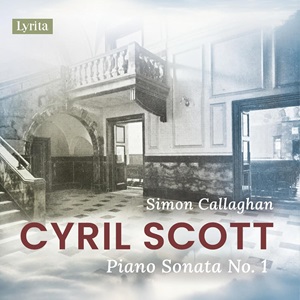
Cyril Scott (1879-1970)
Piano Sonata No 1, Op 66 (1909 rev 1930s)
No 1 from ‘Two Piano Pieces’: At Dawn, Op 37 (1904)
No 1 from ‘Two Pierrot Pieces’: Pierrot triste, Op 35 (1904)
Simon Callaghan (piano)
rec. 2021 (Sonata) and 2023 (remainder), Wyastone Concert Hall, Monmouth
Lyrita SRCD437 [39]
I think we need to address the problem. Why has Lyrita released a 39-minute disc containing just Cyril Scott’s Piano Sonata, Op 66 in its 1930s revision, to which it’s added two brief little makeweights? Why were they recorded at different times two years apart? I’ve been head-scratching about this and can come up with a few ideas that may well be a long way from the truth. Perhaps Simon Callaghan is unconvinced by Scott’s other sonatas and didn’t want to record them, or perhaps other competing recordings make this a dicey prospect. Leslie De’Ath recorded all three numbered sonatas and added the unnumbered Sonata, Op 17, in his Dutton disc twenty years ago – part of his extensive series. Michael Schäfer recorded Nos 1-3 and some characteristic pieces for Genuin at the same time. Maybe Callagan and Lyrita believe the 1930s revised version has sufficient clout to attract listeners, but frankly I can’t believe that. Possibly the Sonata has been in the can for two years and Callaghan returned to Wyastone to record two little pieces and then flung up his hands crying; ‘I can’t take any more Cyril Scott. Let me out of here.’ In fact, I’m at something of a loss to explain this release, not least because it seems to be on sale at something less than full price.
Still, let’s focus on what’s here. In his booklet note, Brian Inglis mentions that the revised version of the sonata simplifies some rhythms and enriches the harmonies. The differences have been discussed in Lisa Hardy’s The British Piano Sonata (Boydell Press, 2001). I’m unaware of a previous recording of the revision, though there may well have been one for all I know. Even Dennis Hennig’s Etcetera recording was of the 1909 original, as were the recordings of De’Ath and Schäfer.
The first numbered sonata is Scott’s best-known example, composed in 1908 and published the following year – his most forward-looking, demanding, virtuosic and valuable. It was dedicated to Alfred Hoehn, a fellow student in Frankfurt and one who, like Scott, studied with Lazzaro Uzielli. Like Scott, Hoehn was recorded, so we know what his pianism was like. The Sonata opens in vaguely folkloric fashion but soon becomes subject to Scott’s near-constant changes of metre, remarkable for their flexibility and sense of fluidity. The revision ratchets the Scriabinesque element so that at times these fugitive moments become almost oppressively insistent. Whether because he’s playing the revised edition or not – I’m afraid I don’t know the exact nature of the revisions but surely regularising rhythms and adding notes to thicken harmonies are to do with greater simplicity and increased harmonic density not greater length – Callaghan seems to play with a sense of rubato that seems excessive, particularly in the opening movement. Whether this is ‘Allegro, con spirito’ I’m not convinced. Schafer’s 8:15 in this movement certainly sounds brutal next to De’Ath’s 11, but Callaghan takes 13:40. Thereafter, the tempi are more standard but at Callaghan’s tempi I didn’t feel the first and second movements sounded distinguished one from the other. I liked his puckish wit in the Scherzo and the much-admired Fugal finale is admirable though, once again, I prefer De’Ath’s tempo, faster and more linear. Percy Grainger sometimes played just these last two movements in concert and his ambivalence at Scott’s revisions is notable and instructive.
The two little pieces are, contextually, neither here nor there, though again Callaghan tends to be too lateral for my tastes. You are free to disagree.
What we have here therefore is the 1930s revision of Scott’s best sonata, with two representative small pieces – a salon trifle and a rather more expressive commedia dell’arte example. I’m very surprised by this disc as I don’t believe, in terms of its timing, that it has any precedent in Lyrita’s catalogue. With at least three versions of the original Sonata available I’m not wholly convinced that the revision will have much appeal other than to specialists.
Jonathan Woolf
MusicWeb was contacted by Adrian Farmer, director of Nimbus, who explains that “the sonata was recorded during lockdown, and held back; the opportunity came to release it in support of the artists celebratory Wigmore Hall recital given in January this year which featured the Scott sonata. We subsequently decided to make it a general release, and since the moment had passed where more substantial pieces could be added to the repertoire, we decided to go with what we had, and to price the CD appropriately for its playing time. It will also enjoy a place on streaming platforms which, and this is the good news, are freeing creators from the ‘album’ restrictions we have lived with since the 1980s. Times are changing.”
Help us financially by purchasing from



















